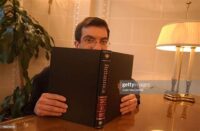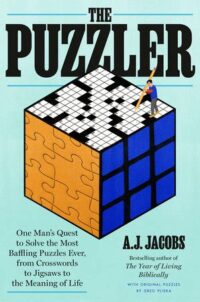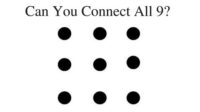
Curious Not Furious
Although I’ve never admitted it in public (until now, that is), I am a longtime AJ Jacobs fan. He’s a quirky man who writes quirky books about quirky topics which he takes to absurd lengths. They are funny with their humor often coming at Mr. Jacobs’ expense.
Most of them deal with subjects I’m only vaguely interested in. In one, he tries to track down how many people he (and we) are related to. In another, he explores all the people who contributed something to the cup of coffee he buys every morning. He even wrote The Know-It-All about what he learned from reading the entire Encyclopedia Brittanica (I hadn’t stooped so low as to read that one perhaps because my mother used to call me Mr. Know It All, but hold on to your intellectual hats until you reach the end of this post).

In other words, his books are cute. They do have some intriguing life lessons embedded in them, but their cuteness to usefulness ratio was bad enough for me to decide that the time had come to break my Jacobs habit when I heard about The Puzzler. Then, while on a recent walk, I listened to a podcast he did in late September for the Next Big Idea Club which changed my mind. (You should also read this as an unsolicited plug for the club of which I’m a charter member because it keeps me up to date with new non-fiction books that I absolutely have to read but didn’t know it).

Jacobs’ interviewers happened to have known him since they were all undergrads at Brown in the 1990s which convinced me that theirs must have been one hell of a class. But as I listened while walking to my grandkids’ house (more on one of them later because he is about to become a Jacobs addict), two lines in it sent my Kindle into ordering mode as soon as I got home.
First, Jacobs revealed that at 10:01 (eastern time) each evening, he goes to the New York Times web site because that’s when they reveal the next day’s crossword. If I’m up that late (which is rare), I do the same thing (he doesn’t tell you that early-to-bed types like me get it easy on Saturdays and Sundays because the puzzles are released at 6:01 on the weekend).
Second, he revealed one of the life lessons he learned from his year or so researching puzzles. When confronted with a tough problem:
be curious, not furious.
Since I work on tough conflicts for a living, I ordered the book for my Kindle and dug right into it.
Three Life Lessons
Here, I’m not going to focus on acrostics or Wordle (which barely gets mentioned) or even my beloved crosswords. To be sure, reading about the 43 quintillion possible ways to twist a Rubik’s cube, the politics involved in determining whether a given word is acceptable in the New York Times SpellingBee game, or the efforts to decolonize yet another industry dominated by aging white men like Jacobs—and me—can be enlightening and a lot of fun.

However, I want to l focus on the usefulness rather than the cuteness side of the book. More interesting to me, however, are the three interconnected conclusions I drew from the book, culminating in the one that convinced me to read it in the first place and gave this post its title.
Puzzles not Problems. The first is to think of life as consisting of puzzles rather than problems.
When I think of a problem, it brings to mind modifiers like unsolvable or intractable.
But what if I think of them as puzzles?
That simple switch from one p word to another shifts your orientation toward solution rather than obstacles and obstructions. It may take you ages to get to a solution, but if your mindset focuses on solutions, you start thinking creatively about what we can do about the climate crisis.
In fact, the climate crisis is an even better example than Jacobs probably realizes. We have probably turned a corner toward reaching a sustainable future, not so much because people have pointed fingers at the companies and governments that have blocked climate change but because scientists and entrepreneurs who treated it like a puzzle have developed partial solutions, involving renewably sourced energy, conservation, and the like.
That resonates in my own work in which everything I do these days focuses on finding potentially constructive solutions to our problems.
Oops, I mean puzzles.
Paradigm Shifts and That Damned Clichéd. As Jacobs reminds us, the phrase thinking outside the box actually comes from an ingenious solution to a real puzzle that has been around for as long as I can remember.
You all know it. Someone asks you to connect these nine dots using four lines but never taking your pencil off the page.

The first time you do it, you’re stumped until someone literally goes outside the box and shows you the solution. That’s what happened to my grandson. And to me.
 If Jacobs (and my conflict resolution colleagues) are right, you can never solve a tough problem if you look at it in the same old way. As Einstein once put it in a statement he made but never wrote down and thus gets quoted in a number of different ways (how’s that for Mr. Know-It-All):
If Jacobs (and my conflict resolution colleagues) are right, you can never solve a tough problem if you look at it in the same old way. As Einstein once put it in a statement he made but never wrote down and thus gets quoted in a number of different ways (how’s that for Mr. Know-It-All):
You can never solve a problem on the same level you created it.
You need a new mindset that can lead to cool new insights which is what design thinking, for example, is all about. Or, to use a word Jacobs and I both use a lot, you need a paradigm shift. Creativity comes from thinking in new ways and often doing so by working with diverse teams. Or taking a break to find new inspirations if you have to work on your own. Or lateral thinking that lets you bring seemingly unconnected ideas or strange political bedfellows together.
You won’t get it right the first time. Or the second. Or maybe even the third.
Which is why Jacobs advocates using pencils and lots of erasers. And design thinkers start by making cheap prototypes before they get to minimum viable products. Emphasis on minimum.
But eventually, you just might find the cool new approach by thinking outside of your mental box on problems that are a more difficult than connecting nine dots…..
Curious not Furious. The final one is the most important lesson and not just because it gave me the title for this post.
Given the first two points, approaching the constraints that go hand in hand with tough problems with a curious mindset can spark creativity. Requiring four lines without taking your pencil off the paper are constraints. Research on the dots puzzle and many other problems reinforces Jacobs’ conclusion the curiosity can lead to outside the box solutions on problems that matter—not just stupid games. That’s especially true because we know that diverse teams that build on their differences while working together often produce the most creative outcomes.
Here, I think that Jacobs, if anything, understates his case. Or perhaps his need for cuteness obscured the power of what he was trying to say at least for this reader.
That kind of creativity rarely emerges when you are fighting either the problem itself or the people you share it with. To return to the question of climate change that Jacobs and I both care about, curious but not furious activists like Katherine Hayhoe and Bob Inglis have pioneered ways of getting tree huggers like me and petrochemical workers like those Hayhoe teaches to come up with creative initiatives that can both tackle aspects of climate change in ways both of us are delighted by.
Here, to borrow a term from his native world of journalism, Jacobs may have buried the lede because only gets to this point on p. 236 (at least in the Kindle edition).
You need to try to see the world from the solver’s point of view.
You can’t do that if you start furious.
More polarization and finger pointing won’t solve any of the problems facing our country—or our planet or our neighborhood or our ????.
If I think of oh, say, Republicans, as the focus of evil in the world and refuse to work with them, I eliminate roughly half of the available brainpower at a time when many of those puzzles might be easier to solve if we bought all of our creativity to bear to find the equivalent of those four straight lines drawn without taking our collective pencils off of the paper.
Curious not furious may not work all the time. But it helps people who disagree focus less on their differences and more the aspects of a problem that they share and that they can only solve together—something social psychologists call a superordinate problem.
And you can’t get there if you don’t understand where the person on the other side is coming from. You don’t have to agree with them. That takes empathy, an important word I hope he unfortunately doesn’t include in the e chapter of the book on the encyclopedia.
I Know It Helps
While reading the book, I realized that what might have been a throw away line was anything but that, because an email from a friend convinced me that Jacobs is on to something.
Ron Rapoport and I were Oberlin classmates and have remained good friends perhaps because we both became political scientists and share a lot of interests—including a fascination with A. J. Jacobs.
While I was reading The Puzzler, I got an email from Ron about the most recent self-inflicted conflict Oberlin is going through. Trust me, there have plenty of them in the half century since we did our part to create some of those conflicts when we were student leaders on opposite sides of the political fence in the 1960s.
So, I started thinking about Oberlin’s conflicts as puzzles and realized that there have been a few times when the College got things right. Sure enough, on those occasions the students, faculty, administration, alumni, and local community acted as if they had sat at Jacobs’ intellectual feet:
- They treated the problem as something they had to solve and had to solve together
- They realized that they had to try something new
- They started by figuring out why they disagreed so sharply and went from there.
My Grandson’s Dilemma
Last but not least, Jacobs’ books gave me two ways to connect even more with my intellectually precocious, eleven-year-old grandson to whose house I was walking when I heard that podcast.
He had already shown some interest in the puzzles I told him about that morning, including the famous dots and the crossword clue GEGS (you’ll have to buy the book to find the answer or cheat by using Ecosia—more on that later). So, I bought him his own copy that arrives today.
Then, I ordered him a copy of The Know-It-All after I realized that Kiril might also get a kick out of what Jacobs says about some a, b, and c words like augury, bedlam, and Cleveland (which is, of course, just down the road from Oberlin and the last entry I read before writing the first draft of this post).
Unfortunately, I realized that the real world has caught up with venerable encyclopedia. Kiril is probably as curious and weird as I was when I thought about but never did read the entire Britannica. I didn’t get beyond the first couple of pages because, well, I got bored.
It will be different for Kiril. He will not able to sit down with all thirty-six volumes (not to mention the annual yearbooks) because the Britannica went fully on line even before Wikipedia redefined encyclopedia writing by, ironically, learning Jacobs’ three lessons and thought outside the box. Today, you can’t read the Britannica from A to Z because it only exists on line and has even more entries and virtual pages than Jacobs read. I know that because I was asked to write a bunch of articles for the online Brittanica, none of which were important enough to include in the print edition.
Instead, Kiril’s approach to becoming a know-it-all will have to be different. It will be more random but it will probably take him farther and help him better learn the life lessons in The Puzzler.

He loves to use Ecosia to explore seemingly random intellectual rabbit holes on the web (if you don’t know about Ecosia and care about climate change, here’s the link). He has taken me down lots of creative, non-alphabetically ordered journeys that have taught me about ASAP Science and Kurzgesagt (if you have nerdy eleven year-old kids or grandkids, look them up).
He may well miss a lot of things that Jacobs got when he read the encyclopedia from cover(s) to cover(s).
But he will retain more and he will solve more puzzles.
Still, his copy of The Know-It-All will arrive on Thursday by which time he will have finished The Puzzler. He won’t have solved most of the puzzles. Hell, I couldn’t (including GEGS for which Ecosia also didn’t help). But, we’ll have fun learning how to do them together, starting with my next book, since we are writing the final chapter together.
The views and opinions expressed in this article are those of the author and do not necessarily reflect the official policy or position of the Alliance for Peacebuilding or its members.
Also published on Medium.





